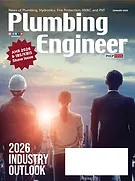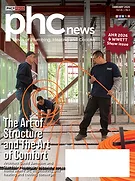Imagine taking a refreshing shower, thinking about the day’s activities, when all of a sudden it happens. Whoosh! Someone flushes the toilet, and without delay, the water turns hot. Scalding hot. There’s nowhere to turn or to get away to. You’re stuck with the stinging pain of the hot liquid torching your skin.
Being scalded can happen to anyone, but hot water isn’t the villain. Without it, sanitation and health would decline rapidly. There are a couple of reasons why this happens though, and once we identify them, we can provide adequate solutions which mitigate the hazard and prevent the aforementioned scenario.
If not properly designed, installed and cared for, plumbing systems can be the source of a lot of headaches. That’s because it’s really not as simple as the old joke goes: “There are three rules to plumbing: Hot on the left, cold on the right.” “Never bite your fingernails.” And my favorite, “Payday is on Friday.”
For our purposes, I want to focus on two items, pressure and temperature. Improper blending of temperatures and imbalance of pressures in the system simply wreak havoc. Hot water accounts for approximately 20 percent of burn-related injuries, which, according to the most recent estimate by the Burn Foundation, is 1.25 million injuries per year in the United States. Furthermore, the Consumer Product Safety Commission (CPSC) states that over 30 people a year die from water-related burns. The severity of a scald injury is based on two factors: the water temperature and length of time exposed.
Building owners and design engineers should identify the actual usage of the facility and apply basic concepts, so that system components work in conjunction to provide proper delivery temperatures at the point of use. From the perspective of a parent, business owner, homeowner, etc., prevention is key.
We have to be diligent to safeguard young children, disabled persons and the elderly. These individuals have been identified as being more susceptible to skin burns and require additional help maneuvering sinks, baths and shower valves. In addition to the plumbing system upgrades mentioned within this article, temperature monitoring can provide data required to protect families and employees. This can be achieved either by building information systems or a simple thermometer available as bathtub sticker or floating toy.
When examining a building plumbing system to identify hazards, first consider the storage and delivery temperature setting at the water heater or heating source. The International Plumbing Code forbids the use of the water heater thermostat setting as a means to regulate the delivery water temperature, and the Uniform Plumbing Code requires anti-scald devices for protection of users.
Besides common-sense reasoning that things break and fail, these sensors within the tank are not always located such that they are monitoring the hottest water, due to stratification, or layers of varied water temperatures, as the hottest water rises. Also consider that an instantaneous water heater delivers a water temperature based on a temperature rise and not on a temperature limitation, so time of year and groundwater temperature must be taken into account when determining delivery water temperature.
It should also be taken into consideration that bacteria growth conditions are ideal in lukewarm environments, so circulating tepid water can also tip the safety scale in an unfavorable direction. Ideally, 140 F water should be available to circulate throughout the system in order to purge potential microbial development (a process which takes 32 minutes using 140 F water). However, general-use water temperatures in excess of 105 F are considered to be harmful. Therefore, even when water is circulated at 120 F, the standard water heater factory setting, it’s best to provide mixing valves for final delivery at washing facilities so that users are not exposed to high water temperatures.
The following scale shows approximate burn times as the temperature increases. The U.S. CPSC also notes that dialing the temperature setting back is more energy efficient and less costly.
So what are the options? A thermostatic mixing valve blends the required amount of hot and cold to deliver a specific temperature within a few degrees. Temperature limit stops are simply a physical barrier which prevents the handle from being turned outside a minimum and maximum range. Pressure balancing is a separate feature which does as the name suggests and stabilizes the pressure of the incoming hot and cold water flow which moderates pressure fluctuations within the system caused by sporadic and simultaneous fixture usage.
It is possible to have both temperature and pressure regulating safety features within a single handle. These components can also be purchased individually and installed in conjunction with fixtures with dual-control handles or fixtures which do not have built-in safety features. The American Society of Sanitary Engineering (ASSE) set forth requirements in 2004 as part of standard 1070 for performance of temperature limiting devices, in addition to ASSE 1016, regarding point-of-use temperature and pressure-balancing devices and ASSE 1017 for thermostatic mixing valves for distribution in hot water systems.
However, a common issue with installation of these devices is that reversal of the hot and cold water, such that cold is counterclockwise, and hot is in the clockwise direction. If relying on muscle memory, one might be surprised to find that the water temperature is opposite of what they’ve expected to feel. This can be due to the cartridge or stem of the cartridge being installed backwards, or worse, transposed routing and labeling of pipes. Additionally, pressure balancing spool pieces can become rigid when not used for a period of time. Again, prevention is key, and knowledge is power.
The plumbing industry has significantly advanced since Al Moen invented the single-lever shower valve in 1939, and it began production in 1947. Single levers once provided a singular solution for the user to temper the water either more hot or cold depending on the arc length. Modern advances and digitization have made volume control, temperature over-rides, and temperature-setting memorization possible with the touch of a button. Pre-programmed user settings are available on a wide range of fixtures, making the washing process luxurious and by using less water for the same, if not more, level of comfort.




